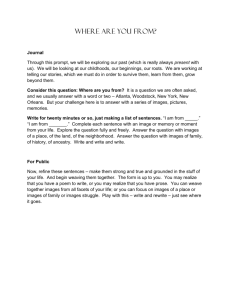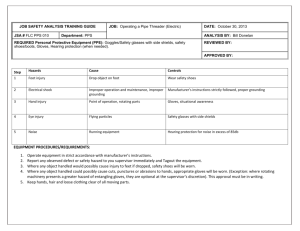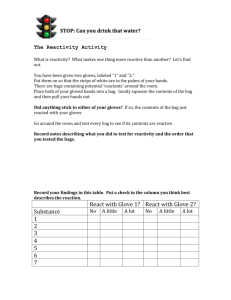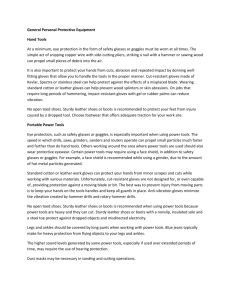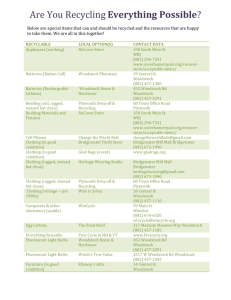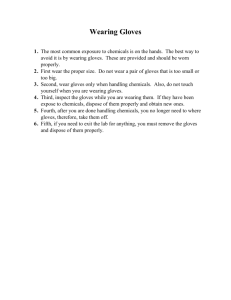The Woodstock Glove Industry
advertisement
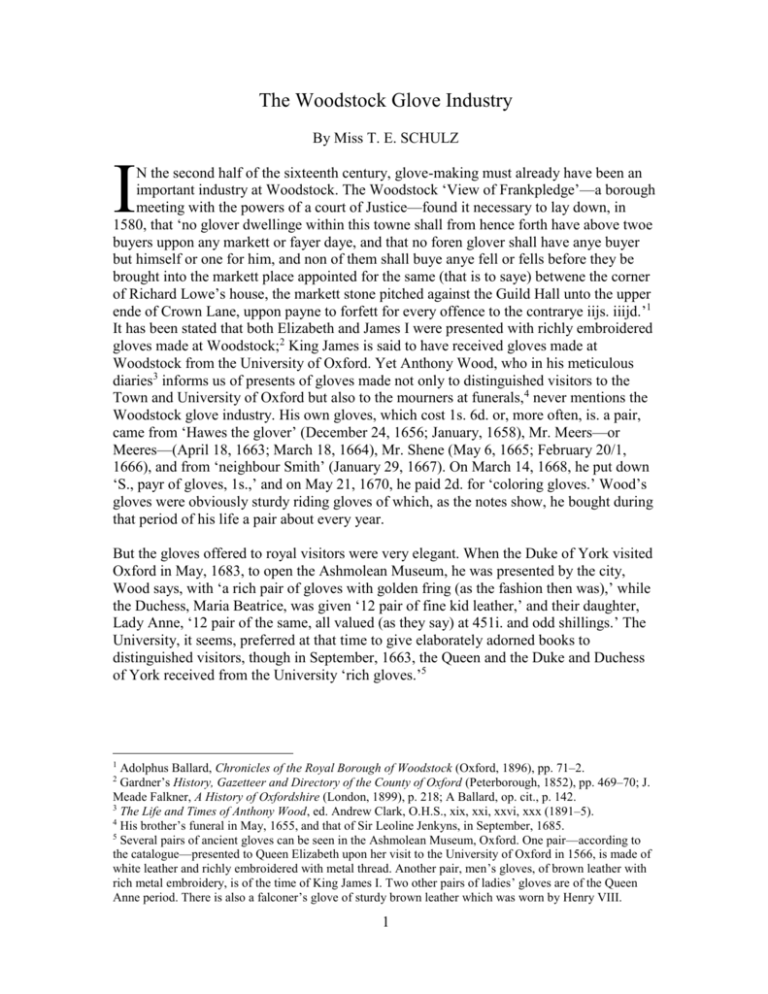
The Woodstock Glove Industry By Miss T. E. SCHULZ I N the second half of the sixteenth century, glove-making must already have been an important industry at Woodstock. The Woodstock ‘View of Frankpledge’—a borough meeting with the powers of a court of Justice—found it necessary to lay down, in 1580, that ‘no glover dwellinge within this towne shall from hence forth have above twoe buyers uppon any markett or fayer daye, and that no foren glover shall have anye buyer but himself or one for him, and non of them shall buye anye fell or fells before they be brought into the markett place appointed for the same (that is to saye) betwene the corner of Richard Lowe’s house, the markett stone pitched against the Guild Hall unto the upper ende of Crown Lane, uppon payne to forfett for every offence to the contrarye iijs. iiijd.’1 It has been stated that both Elizabeth and James I were presented with richly embroidered gloves made at Woodstock;2 King James is said to have received gloves made at Woodstock from the University of Oxford. Yet Anthony Wood, who in his meticulous diaries3 informs us of presents of gloves made not only to distinguished visitors to the Town and University of Oxford but also to the mourners at funerals,4 never mentions the Woodstock glove industry. His own gloves, which cost 1s. 6d. or, more often, is. a pair, came from ‘Hawes the glover’ (December 24, 1656; January, 1658), Mr. Meers—or Meeres—(April 18, 1663; March 18, 1664), Mr. Shene (May 6, 1665; February 20/1, 1666), and from ‘neighbour Smith’ (January 29, 1667). On March 14, 1668, he put down ‘S., payr of gloves, 1s.,’ and on May 21, 1670, he paid 2d. for ‘coloring gloves.’ Wood’s gloves were obviously sturdy riding gloves of which, as the notes show, he bought during that period of his life a pair about every year. But the gloves offered to royal visitors were very elegant. When the Duke of York visited Oxford in May, 1683, to open the Ashmolean Museum, he was presented by the city, Wood says, with ‘a rich pair of gloves with golden fring (as the fashion then was),’ while the Duchess, Maria Beatrice, was given ‘12 pair of fine kid leather,’ and their daughter, Lady Anne, ‘12 pair of the same, all valued (as they say) at 451i. and odd shillings.’ The University, it seems, preferred at that time to give elaborately adorned books to distinguished visitors, though in September, 1663, the Queen and the Duke and Duchess of York received from the University ‘rich gloves.’5 1 Adolphus Ballard, Chronicles of the Royal Borough of Woodstock (Oxford, 1896), pp. 71–2. Gardner’s History, Gazetteer and Directory of the County of Oxford (Peterborough, 1852), pp. 469–70; J. Meade Falkner, A History of Oxfordshire (London, 1899), p. 218; A Ballard, op. cit., p. 142. 3 The Life and Times of Anthony Wood, ed. Andrew Clark, O.H.S., xix, xxi, xxvi, xxx (1891–5). 4 His brother’s funeral in May, 1655, and that of Sir Leoline Jenkyns, in September, 1685. 5 Several pairs of ancient gloves can be seen in the Ashmolean Museum, Oxford. One pair—according to the catalogue—presented to Queen Elizabeth upon her visit to the University of Oxford in 1566, is made of white leather and richly embroidered with metal thread. Another pair, men’s gloves, of brown leather with rich metal embroidery, is of the time of King James I. Two other pairs of ladies’ gloves are of the Queen Anne period. There is also a falconer’s glove of sturdy brown leather which was worn by Henry VIII. 2 1 T. E. SCHULZ Oxford, indeed, was famous for its gloves for many centuries; the industry can be traced hack to the end of the thirteenth century.6 A glovers’ guild was formed in the first year of Edward IV (1461).7 Glovers—Philip le Ganter, Laurence le Gaunter, Henry le Gaunter, Eudo le Gaunter—figure among the sworn men at inquests at the end of the thirteenth and the beginning of the fourteenth century.8 Robert Plot, writing in 1677, said that ‘Oxford had the reputation of the best gloves and knives, of any place in England.’9 and Anthony Wood stated, ‘the streame’ (i.e. Cherwell) . . . ‘has soe great vertue therin that all skins of a more delicate kind (as it has bin generally observed) are soe well seasoned with it for the making of white leather that none whiter softer or better is hardly found,’ to which he added the marginal note, ‘which is another reason perhaps why Oxford gloves have been commended.’10 The presentation of gloves to distinguished visitors, was not, however, peculiar to the Town and University of Oxford. Since the time of Elizabeth gloves had become generally articles of presentation to royalties and noblemen, and Queen Elizabeth and her courtiers, for instance, were presented with gloves also by the University of Cambridge on the Queen’s visit in 1564,11 on which occasion the gloves appear in the company of ‘marchpane,’ ‘comfits,’ and sugar loafes. The fashion of wearing highly adorned and perfumed leather gloves spread to England from the continent in the sixteenth century. ‘Sweet’ or ‘perfumed’ gloves were not infrequently among the gifts given to Elizabeth on New Year’s Day.12 Yet at that time gloves were not an absolutely necessary article of dress for the elegant lady, as seems to be confirmed by the omission of gloves in those of Queen Elizabeth’s numerous proclamations against excess in apparel which are now in the Bodleian Library, though these contain regulations relating to garters, petticoats, and ‘excessive ruffs.’ It is important to consider the demand side of the glove trade at that time, if one wants to understand the development of the industry in a particular locality. The first leather gloves were used for riding and hawking, and there was a natural demand for them in those parts of the country which were frequented by noble hunters, such as Oxford and, especially, Woodstock.13 The deer in the woods provided the raw material for the trade at this early time; later, sheep-skin became an important raw material. But the frequent references to kid gloves given to noble visitors, and Wood’s mention of the white and soft leather, which derived its special virtue from the water of the Cherwell, indicate that the Oxford glovers also produced—and were famous for—what nowadays are called ‘light’ gloves, as distinguished from hard-wearing ones. It is not improbable that the import from the continent of skins especially suited for the making of elegant gloves affected adversely the 6 V.C.H., Oxford, ii, 228, 256. Ibid., p. 256. 8 H. E. Salter, Records of Medieval Oxford (Oxford, 1912), pp. 6, 12, 13. 9 Robert Plot, The Natural History of Oxfordshire (Oxford, 1677), p. 280. 10 Anthony Wood, Survey of the Antiquities of the City of Oxford, composed in 1661-6, ed. Andrew Clark, O.H.S. xv (1889), 395. 11 John Nichols, The Progresses and Public Processions of Queen Elizabeth, III (London, 1805). 12 John Nichols, op. cit., vols. II and III (years 1577–8; 1588–9; 1578–9; 1599–1600). 13 Some 60 years ago falconers’ gloves were still made occasionally by one of the Woodstock glove manufacturers. They were of heavy deer-skin or sheep-skin with a lining of light chain-armour between two layers of leather on the back of the hand. (Information supplied by Mr. Marston Money, Woodstock). 7 2 WOODSTOCK GLOVE INDUSTRY demand for Oxford gloves—just as in 1826, when the import of foreign-made gloves into England was legalized,14 the London and the Yeovil glove trade, which used largely imported skins, are said to have suffered severely from the competition of the relatively cheaper French gloves.15 Woodstock, surrounded by large forests well stocked with deer, was a favourite residence of many English kings.16 Henry II, the lover of Fair Rosamund, stayed frequently at the Royal Manor in the Park of Woodstock. ‘At that time there was a certain waste place without the said park and manor; and because the men of the said King were lodged too far from the manor house aforesaid, the said Lord the King with the unanimous assent and counsel of his nobles gave and granted divers parcels of land of the said waste place to divers men to built hostelries there for the use of the men of the same King.’17 This was the beginning of New Woodstock. Ballard mentions the large number of trades-men living at Woodstock in 1279,18 established there, of course, to serve the needs of the court. But the people of Woodstock did not gather riches; when in 1327 a tax of one-twentieth was levied, only 18 persons in New Woodstock were assessed, though the number of houses had already in 1279 amounted to 137, and the population to about 540.191 It seems probable that at a very early date people not only at Woodstock but also in other places which came in contact with the hunters of the royal parties at Woodstock Manor, began making gloves for hunting and hawking. On the occasion of large royal entertainments the villages near Woodstock were probably frequently filled with guests. We are told, for instance, that this was the case when, in 1256,Alexander III, King of Scotland, and his Queen, Margaret, daughter of Henry III, were entertained by the Queen’s father at Woodstock.20 It is interesting to note that until the beginning of the twentieth century the gloving villages of the district were practically all situated on the borders of or within the ancient Wychwood Forest; ‘outside these villages,’ Ballard wrote, ‘there are very few gloveresses.’21 Of these villages, Bladon, Combe, Stonesfield, and Wootton are already mentioned in Domesday Book; Finstock, Fawler, Ramsden, and Leafield sprang up at later dates in the middle of Wychwood Forest.22 In all these villages, The import of foreign gloves had been forbidden under Elizabeth (5 El., 7), because ‘by reason of the aboundaunce of forreyne wares, brought into this Realme from the partes of beyonde the Seas, the sayde artificers are not only Iesse occupyed and thereby vtterly impoverished .. . but also diuers Cities and Townes within this Realme of England much thereby impayred.’ 15 William Hull, The History of the Glove Trade (London, 1834), pp. 54-5, 70-2. 16 Edward Marshall, The Early History of Woodstock Manor (Oxford, 1873). 17 Hundred Rolls, ii, 839 ; quoted from A. Ballard, op. cit., pp. 7-8. 18 A. Ballard, op. cit., pp. 9-10. 19 Ibid., pp. 8, 13. 20 E. Marshall, op. cit., pp. 82–3. 21 A. Ballard, op. cit., p. 143. 22 A map of 1574 (Brit. Mus., maps cat. C.7, c. i) shows the forest of Wychwood covering the area between the Evenlode and the Windrush and bounded by a line stretching from Ascott-under-Wychwood straight south to the Windrush, touching Witney, North Leigh, Handborough, and then turning north to the Evenlode, while Woodstock Park is encircled by Bladon, Combe, Stones-field, Wootton, and Woodstock. For the early limits of the forest of Wychwood see also Cart. of Eynsham, ii (O.H.S. li), 92–6: Archaeologia, xxxvii, 424–35. 14 3 T. E. SCHULZ with the exception of Bladon, Combe, and Wootton, glove-making is still a very important cottage-industry. In 1576, Woodstock was made by Elizabeth a staple of wool and yarn.23 This in itself indicates that there must have been a very considerable amount of sheep-raising in the neighbourhood. As early as 1517, a commission on enclosures had found that in the Hundred of Wootton the whole area returned as enclosed was enclosure for pasture.24 A sheep and cattle farmer on a very large scale was Sir Henry Lee, Lieutenant of the Manor of Woodstock and Ranger of the Park under Elizabeth. From his forbears (who already had enclosed land for pasture on a large scale)25 he had inherited an estate in Buckinghamshire. There, we are told, he lost through floods, in 1571, some 3,000 sheep, besides much cattle and horses.26 In the same year he leased some pasture-land near Spelsbury for 21 years. Between 1583 and 1601 he acquired the manor houses of Ditchley and Spelsbury, and nearly 3,000 acres of mainly arable and pasture-land in that part of Oxfordshire.27 In 1576, he obtained a special licence to export 200,000 calf-skins. Sir Henry Lee’s sheep and cattle farming must have had some effect on agricultural employment at and near Woodstock. We learn of a dispute between Sir Henry Lee, on behalf of the Crown, and some inhabitants of Woodstock,28 in the course of which Sir Henry Lee complained to Lord Burleigh (his cousin) that the people had been cutting down the Queen’s trees and ploughing up her pasture; which pasture was, presumably, to be used by the Lieutenant of the Queen’s manor. Sir Henry Lee was successful with his cleverly worded claim.29 In 1617, a ‘humble petition’ was presented to Parliament by ‘the inhabitants of the severall towneships of Wotton, Hordley, Oulde Woodstocke, Bladon, Stonefield, Coombe, and Handborough, adjoyning to his maties maunor house of Woodstocke in the county of Oxon.’ They complained ‘that these towns were not a forest until a Justice Court holden at Woodstock by the Earl of Holland, Chief Justice in Eyre, when a perambulation was formed, and certain parts not previously within the regard of the forest of Wychwood were included therein. That there had been no red nor fallow deer within these townes, until about six years before, when they were brought into the park by Sir Henry Lee, who also took a piece of ground for their restraint, whereon the petitioners had a right of common. That the said deer had broken out and done much damage . . . And they alleged, that by the premises, not only their freedom, but even their livelihood was taken from them, and that many more would receive injury unless redress should be afforded.’ This was signed by 116 petitioners.30 It seems unlikely that there were no red or fallow deer in 23 E. Marshall, op. cit., p. 160. I. S. Leadam, The Domesday of Inclosures (Royal Historical Society, London, 1897), 1, 321. 25 Especially his grandfather, Robert Lee: Sir E. K. Chambers, Sir Henry Lee (Oxford, 1936), pp. 14-15. 26 Viscount Dillon in A History of Spelsbury (Edited by the Hon. Elsie Corbett, Shipston-on-Stour, 1931), pp. 108–10. 27 Ibid., p. 136. 28 Ibid., p. 131, and E. Marshall, op. cit., p. 161. 29 Sir Edmund Chambers points out that the object of the enlargement of the Park of Woodstock was probably to make better provision for the maintenance of deer (op. cit., pp. 92-3). 30 E. Marshall, op. cit., pp. 177-9. 24 4 WOODSTOCK GLOVE INDUSTRY the park of Woodstock before the time of Sir Henry Lee’s lieutenantship, for we are told that, although for a long time English kings did not hunt in the park in consequence of a prophecy, Henry VIII had disregarded the warning because of the ‘christian and faythfull counsayle of that Queene’ (i.e., Anne Boleyn).31 Sir Henry Lee, however, is likely to have considerably increased the deer in the park,32 and the ‘humble petition’ was directed in part against the damage done to agriculture in the district and in part against the imposition of the very severe forest laws. Thus a number of factors developed favouring the growth of enterprise supplementary to agriculture in and near Woodstock; on the one hand, there was a shortage of agricultural employment, while, on the other, there was a demand for certain articles of wear by members of the hunting parties, and ample supply of sheep-skin and deer-skin. In the seventeenth century, Woodstock was situated in the middle of the area of Civil War, and until Blenheim Palace brought new splendour to Woodstock, the demand for Woodstock gloves was probably not very great. Woodstock produced also leather breeches, though it cannot be ascertained at about what time the manufacture of these garments started. There is, however, no reason to assume that Arthur Young was right when he wrote, in 1809, that it began round about the middle of the eighteenth century; for he maintained the same with respect to gloves.33 Neither can the fact that Plot makes no mention of a leather industry of any kind at Woodstock be taken as an indication of its non-existence or insignificance in his time. Plot was no systematic collector of facts, and as often as not omitted essential points while dwelling at great length on minor ones. But, though Young may not have been very accurate when dealing with the past, there is obviously no reason to doubt that, when he was writing in 1809, the making of breeches had ‘dwindled away to little.’ In all records of the nineteenth century we find glove-making mentioned as the only industry of any importance at Woodstock. Once Woodstock had also been famous for the manufacture of polished steel produced exclusively from old horseshoe nails. According to Young this industry had started early in the eighteenth century; but it was possibly much older. This steel was of a very high quality, and Young tells us that a chain weighing 2 ounces was sold for 170 pounds, and that a pair of scissors cost between 5 shillings and 3 guineas.34 About 1765, between 20 and 30 men were employed in this industry, earning between 15 shillings and 2 guineas a week.35 But in 1809, it gave work to 10 or 12 men only; their weekly wages amounted to one guinea or one guinea and a half.36 The development of the steel industry at Sheffield 31 John Foxe, Ecclesiasticall History (3 vols., London, 1570), II, 1233. According to his patent, he was bound to maintain a herd of from two to three thousand deer (E. K. Chambers, op. cit., pp. 82-3). But in 1606 Sir Henry Lee complained that venison in Woodstock Park was scarce, on account of ‘the Kinges oft beinge here, the nomber of deere killed, meny carryed a waye to the newe park at Ritchmond, and exceeding meny dead, through the drowte of the springe was twefemonethe ‘ (ibid., p. 105). This probably induced new measures for the increase and protection of deer in Woodstock Park. 33 Arthur Young, View of the Agriculture of Oxfordshire (London, 1809), p. 329. 34 Ibid. 35 Arthur Young, A Six Weeks Tour Through the Southern Counties of England and Wales, 2nd ed. (London, 1769), pp. 128-9. 36 Arthur Young, View, p. 328. 32 5 T. E. SCHULZ and Birmingham with its mass-production of cheap articles dealt the death blow to the old craft, which soon vanished completely. The only promising industry at Woodstock was, in Young’s time, the glove industry; at present, glove-making is Woodstock’s only industry. In the sixties of the eighteenth century, Young found forty or fifty people employed at glove-making, men and women earning about 8 or 9 shillings a week.37 There exist among the Quarter Sessions Records of Oxfordshire 7 certificates of conviction of Woodstock glovers in Trinity Term, 1788, neatly written on pieces of real parchment : ‘Borough of New Woodstock in the County of Oxford. Be it remembered that on the twenty eighth Day of August In the Year of our Lord one thousand seven hundred and eighty eight Joseph Dewsnap of the said Borough Retail Dealer in Gloves was Convicted before me George Coles Esquire Mayor and one of his Majesty’s Justices of the Peace for the said Borough residing near the place where the Offence was committed for that the said Joseph Dewsnap on the fourth Day of August in the said Year of our Lord one thousand seven hundred and eighty eight did at the Borough of New Wood-stock aforesaid in the said County vend utter and sell to one Richard Lord one Pair of Leather Gloves above the Price and Value of one Shilling and four Pence and Subject to the Stamp duty of three Pence by a certain Act of Parliament passed in the twenty fifth Year of the Reign of his present Majesty King George the third imposed without the Stamped Ticket by the said Act directed to be affixed to the same being affixed and marked and stamped with the Stamp provided and used pursuant to the said Act by the Commissioners appointed to Manage the Duties charged on stamped Vellum Parchment and Paper to denote the said Duty as by the said Act is directed contrary to the Form of Statute in such Case made and provided And I do declare and adjudge that the said Joseph Dewsnap has forfeited the Sum of twenty Pounds of lawful Money of Great Britain for the Offence aforesaid which I do hereby mitigate to the sum of ten pounds ten shillings and sixpence of the like lawful Money to be distributed as the Law direct. Given under my Hand and Seal the thirtieth Day of August—In the said Year of our Lord one thousand and seven hundred and eighty eight. Geo Cole Mayor. There are two such convictions of Joseph Dewsnap, whose case was heard in both instances on August 28th, three convictions of Richard Cross (August 27th), and two of Knapp Money (September 4th). In each case the gloves had been sold to ‘one Richard Lord’ on August 4th, and the fine was for every pair of gloves for which the stamp duty had been evaded £10 10s. 6d. One wonders whether Richard Lord was an excise man or a private ‘informer,’ who, in this way, earned 36 16s. 9d., as, according to the Act and the 37 Arthur Young, Six Weeks Tour, pp. 128-9. Only one reference to glove-making could be traced in the old borough records of Woodstock. The entry was made in 5764, and runs: ‘March l0th. This day Richard Cross was admitted a freeman of this borough having served an apprenticeship to Samuel Heath glover and sworn.’ 6 WOODSTOCK GLOVE INDUSTRY general custom, half of the fines were allotted to him. It seems as though the fines were paid by all, for no further reference to the cases could be found, although the Act contained a provision giving the right of appeal against the judgment to the Justices of the Peace at the next Quarter Sessions.38 On the whole it appears that the glovers of Woodstock were law-abiding people. Except for a case of bastardy which brought a glover and a glove-cutter of New Woodstock, besides a carpenter from the neighbourhood, before the Justices, in 1804, there seem to have been no black sheep among them. In 1805 (Epiphany Sessions) a Geo. Dewsnap, glover of New Woodstock, appeared on the side of the law; he prosecuted a Thomas Dadwell for stealing two skins. Dadwell was convicted. In the records of the Quarter Sessions, a rather interesting case occurs in 1729 (Trinity Sessions), which, however, refers to Burford: ‘Upon Complaint of Thomas Steare of Burford Glover that Elizabeth Webb his Apprentice has very much misbehaved herself in her apprenticeship and hath robbed him and been guilty of severall great misdemeanors the said Thomas Steare is released from his sd apprentice by Mr Beeston Sr Robert Bank Jenkinson Dr Holland Mr Lenthal.’ We have to be grateful that Elizabeth Webb misbehaved herself so badly that her master brought her before the Justices of the Peac; for we thus know for certain that a girl was properly apprenticed to a glover, and it seems likely that this was not an agricultural apprenticeship but one to instruct her in the sewing of gloves. Female apprenticeship of this kind was probably not uncommon. The glove industry at Woodstock seems to have expanded rapidly from the beginning of the nineteenth century. In 1809, Young stated that the industry furnished ‘employment to the poor for many miles round’; there were 60 or 70 men working as ‘grounders of leather and cutters of gloves, who can earn from one guinea to 30 shillings weekly,’ and between 1,400 and 1,500 women and girls the weekly income of whom amounted to from 8 to 12 shillings.39 This must have been the wages for full-time work. As, however, according to Young, the weekly output was only 360 to 400 dozen (pairs, obviously), a considerable number of the gloveresses can only have worked part time; for full-time work, the daily output of a gloveress must have been about three pairs. About 1800, the total output of gloves was much less, though perhaps not quite so small as Young maintains; he states that then the weekly production amounted to but 20 to 30 dozen pairs.40 The leather grounders of Woodstock, said Young, ‘have a peculiar art, in dressing the skin in such a manner as to give it at once fineness of grain and tenacity of substance. The sewers too produce very durable work, and the neatness of the fabric is universally admired. Woodstock gloves likewise possess this advantage: they may be washed several times, and look well and feel comfortable to the hands till they are quite worn out. A pair of doe-skin gloves, which will cost about 5s., will last a gentleman who rides daily, nearly 38 The Act (25 Geo. III, 55) was not in force for long; the stamp duty on gloves was repealed under 34 Geo. III, so, and the payment of one shilling annually for the licence of retailers of gloves, also imposed by the Act, under 36 Geo. III, 80. 39 Agricultural wages in this part of the county were between 10 and 15 shillings per week for male labourers, and for female between 8 pence and one shilling a day. (View, chapter xiv). 40 Arthur Young, View, p. 330. 7 T. E. SCHULZ twelve months; hence they are not only more elegant, but cheaper than the gloves generally made in other places.’ Young recorded in 1809 five principal manufacturers and added, ‘the trade is extremely flourishing.’41 But although Woodstock had developed into an important centre of the glove industry, it was but a small one compared with Worcester and Yeovil.42 According to William Hull there were about 1830 in and around Worcester some 30,000 men, women, and children engaged in the trade, and the potential weekly output was 12,000 dozen pairs,43 while Yeovil’s glove industry gave work to 20,000 persons. Woodstock, situated in a large area of sheep farming, was surrounded by other places famous for centuries for their leather industries. But the special importance attained by the glove industry in northern Oxfordshire is indicated, for instance, by an entry in the vestry book of Burford, in 1818, where it is laid down that ‘a person shall be engaged to learn one person in every poor family to make gloves.’44 Glove-making seems to have been an important remedy against unemployment, at least up to 1825, in the glove-making districts of Oxfordshire. In this context it is interesting to note that the census return for 1851 ascribed the considerable increase of the populations of Charlbury and Wootton during the decade 1841–51 to the fact that people were attracted to these places by the glove industry.45 In 1825, the embargo on importing foreign-made gloves into England was removed, and throughout his book Hull complains bitterly of the damage which this did to the English glove trade; he says that in some places in the north of England the industry came completely to an end. It appears, however, that the anti-freetraders were inclined to exaggerate.46 That an unlucky fate befell some of the English glove manufacturers and their dependants was probably largely because the trade had been fostered artificially in some parts of the country by the general war prosperity, and was unable to hold its own under more normal trade conditions. Moreover, the rapid improvements in communication increased internal competition, which favoured the strong and injured the weak manufacturers. The particular kind of ‘heavy’ glove for which Woodstock was famous47 does not seem to have suffered much at that time from either internal or external competition. Woodstock’s poor rates, indeed, rose steeply from 1825 to 1831.48 But round about 1830 new gloving firms were set up at Witney and Chipping Norton; the founders of the Witney firm are 41 Ibid., pp. 329-30. V.C.H., Worcester, ii, and Somerset, ii, articles on Glove Industry; William Hull, op. cit., pp. 57-62, 69-72. 43 ‘But they are now making something under one-third of that number,’ says Hull (op. cit., p. 58). 44 V.C.H., Oxford, ii, 257. 45 Ibid. 46 See, for instance, The Gentleman’s Magazine, vol. 102 (1832), part I, p. 165 (Proceedings in Parl., Jan. 31). 47 The typical ‘Woodstock’ gloves of ‘deer-skin’ and ‘doe-skin’ are made of leather finished on the flesh side. The heavy ‘deer-skin’ gloves are still made of genuine deer-skin, but ‘doe-skin’ has become a trade name which already in the nineteenth century was generally applied to sheep-skin finished in this peculiar way. 48 William Hull, op. cit., p. 62. 42 8 WOODSTOCK GLOVE INDUSTRY said to have learnt their trade at Woodstock before they migrated to Witney. 49 In 1852, the History, Gazetteer and Directory of the County of Oxford (p. 469), stated that at Woodstock ‘the manufacture of gloves . . . gives employment to many of the inhabitants both of the town and the neighbouring villages’ adding that the trade, though ‘of late much declined, . . . still gives employment to from l00 to 200 men and about 1,500 women and girls; and the number of pairs of gloves made weekly here, average 600 dozen.’ The number of people employed by the industry in the nineteenth century was certainly remarkably large, considering the total number of inhabitants of the borough which, in 1801, amounted to 1,322, in 1851 to 1,250, and in 1901 to 1,106. The number of women and girls working at glove-making in the Woodstock district was given by Ballard at about 2,000 in 1897.50 This was at a time when most of the gloves made at Woodstock were still sewn by hand. Nowadays the gloves are most frequently machined, partly by outworkers but mainly in the factories. The number of outworkers is at present scarcely more than 150 to 20051, while about 180 women and 90 men are employed in the factories at Woodstock. The output per week may be, on the average, 750 to 800 pairs.52 The Woodstock industry profited by the fact that up to the Great War the Army used to wear strong white leather gloves, which could be made especially well by the manufacturers of this borough.53 The orders for army gloves secured by Woodstock firms were often very large and amounted on occasion to 70,000 pairs ordered from a single firm. In the sixties of the last century, the proprietor of an old glove-making firm had the bells of the church rung when he obtained an order for 30,000 pairs.54 These military gloves were all made of English sheep-skin, and pipeclayed to give them a perfect white appearance. The gloves were hand-sewn, and a woman could make between two and three pairs a day, if she worked from early in the morning until late at night.55 The gloveresses were paid for stitching these gloves between 4d. and 5d. a pair. The work must have been anything but pleasant, for the pipeclayed leather was very dusty. There are still people living at Woodstock and in the villages of the district who well remember the time when the gloves were sent out to the gloveresses in bundles of three, 49 V.C.H., Oxford, ii, 258. In this connexion it may be interesting to mention that towards the end of the nineteenth century Woodstock glovers went to Yeovil, there to establish, or re-establish, the manufacture of doe-skin gloves. (Information supplied by old glove-makers at Woodstock and Charlbury). 50 A. Ballard, op. cit., p. 143. Ballard wrote that they ‘thus add a few shillings weekly to the earnings of their husbands and fathers who are mostly agricultural labourers. Some women even earn more than their husbands.’ 51 No records are available from which their number can be ascertained. Outworkers quite frequently work for several manufacturers at the same time. 52 There are at present six glove factories at Woodstock employing over 10 people in the shop. The four largest of them are but branches of enterprises having their centres of gravity elsewhere. Besides there is one one-man workshop. The population of Woodstock is about 1,500. 53 Hull speaks, in 1834, of Yeovil as a place once famous for military gloves, the manufacture of which was ‘now in a state of decay, partly owing to improvident alterations in the military supply’ (op. cit., p. 69). 54 Information supplied by Mr. Marston Money, Woodstock. 55 The modern hand-sewn glove is stitched in a much less painstaking way and a plain glove takes less than half the time that was needed for a military glove. 9 T. E. SCHULZ six, and twelve pairs, with the sewing thread and the money for the last batch of finished work rolled up in each parcel. The collecting and delivering was done once or twice a week by village ‘pack-women,’56 who carried their load on carts, in perambulators, or simply in a sack on their backs. There still (summer, 1936), lives in one of the villages one of these carrier women who used to travel regularly with her horse cart between Chipping Norton, Charlbury, and Woodstock. She is now 85 years old, and pursued her business until a few years ago. She started in her youth as a gloveress, like her mother, and now her grand-child and great-grandchild are employed at glove-making. They, however, stitch their gloves on sewing machines, her grand-daughter in her home, and her great-granddaughter in a small local factory. Little machining was done in the Woodstock glove industry in the nineteenth century, although machine sewing was taken up in some other glove-making districts more generally from about the middle of that century. Machines, however, were used by the Woodstock industry for ‘pointing’ (‘points’ are the ornamental lines which run over the back of the glove pointing up to the fingers) and ‘welting’ (i.e., hemming). The end threads of the ‘points’ were tied together inside the glove by little girls, often not more than 10 years old, working in the factory from 8 o’clock in the morning until 8 at night. Boys of the same age were busy fastening bundles together or doing odd jobs. Some of the old glove-cutters now living at Woodstock started their factory work at the age of 10. Their weekly earnings amounted to half-a-crown. At that time the income of an adult man was between 18 and 25 shillings, if he was a glove-cutter, and between 9 and 12 shillings, if he was an agricultural labourer. Old people at Woodstock and in the surrounding villages all draw substantially the same picture of the life as it was some 60 years ago. The mother made gloves, during the busy periods working regularly several days a week until midnight, and the girls in the family helped as soon as they could do some useful work. Even in one of the village schools they were taught to make gloves; girls 8 and 9 years old would bring with them the gloves which had been stitched together by their mothers, and hem down the binding round the edges under the supervision of the teacher. Often the gloveresses of the village met together in the afternoons or evenings alternately in one of the houses, partly to save light and fuel and partly because in company they got less tired and worked more quickly. In summer they frequently used to do their work sitting in front of their houses. It appears that nowadays glove-making in the form of outwork is kept up mainly in those villages not too closely connected with larger places, while it has died out where transport facilities make the intercourse with towns like Witney and Oxford easy. As long as hand sewing was predominant, the staff of a factory was relatively small, for all the sewing was done by outworkers. Old Woodstock glovers state that a factory with a weekly output of about 200 dozen pairs employed between 10 and 12 cutters, about three women for ‘pointing,’ one for ‘welting,’ and one to sew the buttons on the gloves, besides 56 Some routes were served by male carriers. In that case the distribution and collecting within a village was generally undertaken by a local gloveress. 10 WOODSTOCK GLOVE INDUSTRY two small girls and some boys. (A boy could not get apprenticed until he had reached the age of 14). The full process of transforming the raw skin into leather never seems to have been carried out at Woodstock to any noticeable extent. It is, of course, probable that centuries ago some of the skins which came from the deer in the woods round Woodstock were prepared locally; but no vestige of this seems to have survived in more recent times. In the nineteenth century, the skins were brought to Woodstock after having at least passed through the preliminary process of washing, unhairing, trimming, and ‘fleshing’ (i.e. the removing of scraps of fat before the skins are submitted to the process of tanning and dressing), so that they were ready for the final treatment by which the skins are transformed into leather. Only this, and the dyeing of the leather, were carried out by Woodstock glove-makers. The water of the Glyme was considered especially suitable for making washable leather, while earths found locally were used for colouring it. But when about the middle of the nineteenth century the making of ‘tanned’57 gloves was started at Woodstock, the leather for them was bought in a finished state—frequently imported from the continent—and since the end of that century even washable leather has been obtained from elsewhere in gradually increasing quantities. Chemical and technical inventions have led to the establishment of large leather mills in various parts of the country, whence the leather can be obtained better, and at less cost, than if prepared at Woodstock. Since the War, leather dressing at Woodstock is practically extinct. When all the gloves were hand-sewn very little female labour was employed in a glover’s workshop. And even later on, when machines were used for sewing, the transference of women and girls from their homes into the factories progressed but slowly, for many of the gloveresses lived in villages at a long distance from the factory, and until the bicycle became popular there was no means of transport to make the daily journey to and from the factory convenient to them. Besides, there was at the beginning and during the first decade of the twentieth century in many families a strong aversion to allowing their female members to take up factory work at which they might mix with girls and women of another social grade. Hence, when the demand for machine-sewn gloves increased, several of the manufacturers began to send teachers into the villages to train women for such work. The women learned at the machines which the teacher brought with her, but afterwards had to buy machines of their own. The high price of a machine (about 15 guineas) they paid in instalments which absorbed nearly half their weekly earnings, which seldom averaged more than 7s. and 6d. Nowadays, the income of a proficient machinist amounts to at least 8d. per hour, whether she works at home or in the factory. Sewing-machines are sometimes lent by the factories to the outworkers. High grade machine-sewn gloves are nearly always made in the factory, where the work can be permanently supervised; hand-sewing, however, is always done by outworkers. Women working in a factory can, on the whole, rely on more regular employment; but employment in the Woodstock glove trade is subject to very distinct 57 ‘Tanned’ leather is finished on the fur side of the skin, and shows the grain of the leather. 11 T. E. SCHULZ seasonal fluctuations, with their lowest points in August–September and December– January. Until the end of the nineteenth century there were only local manufacturers in the borough of Woodstock. But at about the time when Adolphus Ballard wrote his Chronicles of the Royal Borough of Woodstock, the merging of individual Woodstock firms in larger enterprises having their centre of gravity elsewhere seems to have begun. This development was the natural concomitant of the technical changes in the manufacture of leather for glove-making. Since there were no longer any natural advantages for dressing the leather at Woodstock, costs of production could be kept lowest if gloving was made a branch of a large leather-dressing firm; or, if glove factories in several parts of the country were linked together so that the leathers could be bought in large quantities through a head office, which could also often market the gloves most advantageously. Nowadays all the main Woodstock factories are but branches of larger enterprises. Since the War, several individual workshops, some of which have been for generations in the same families, have closed down. One small factory which has ceased to exist for some years now had been in the hands of the same family for more than 150 years. In 1809, Arthur Young mentioned the name among those of the more important glove-makers of Woodstock. Other fundamental changes are taking place in the structure of this ancient trade. For several years now no boy has been apprenticed a glove-cutter in Woodstock. The cutting of gloves, once a high-art, is becoming a semi-skilled trade, as nowadays even for expensive gloves perfect workmanship is no longer appreciated—largely because, in consequence of cheaper prices and more frequent changes of fashion, the average life of a pair of gloves has become shorter, and high-grade workmanship shows itself mainly in the fact that even a very old glove has kept its perfect fit.58 Doe-skin and deer-skin gloves, though still a special product of the Woodstock trade, are no longer its main one; a great variety of leather is used, according to the ever-changing dictate of fashion. Since the War, cheap, mass-produced gloves have become a regular line of the trade, besides the manufacture of expensive gloves. The younger generation of workers, both male and female, is emphatically in favour of mass production, for the opinion holds that this line gives the steadiest employment, and the greater remuneration. The ancient craft is turning rapidly into a modern industry. 58 There are, however, still about 40 fully-trained glove-cutters employed at Woodstock, besides about 30 semi-skilled. But even the fully-skilled cutters are doing in part semi-skilled work. 12
